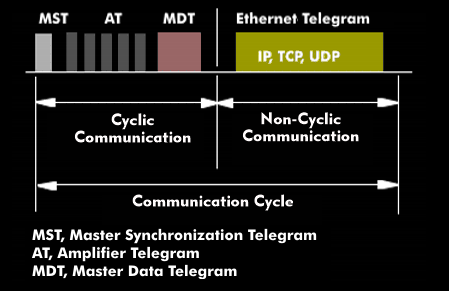sercos frame
In its 3rd version, the sercos interface aims at company-wide communicationbased on Ethernet. Sercos is designed as a fieldbus for automation and communication and consequently for real-time applications that are not supported by Ethernet. For this reason, the communication cycle has been modified and consists of one part for cyclic communication and another for non-cyclic communication.
In the first part of the sercos data frame for cyclic communication, synchronization and control characters as well as data for the master station are transmitted. In detail, this is the Master Synchronization Telegram( MST), which is sent before the control data for synchronization of the master clock. The drives, or slave stations, synchronize to the MST clock and send information to the master station during the time slot. This drive information is contained in the amplifier telegrams( AT). The configurable AT telegrams contain time-critical data about current positions, speeds, torque, etc. At the end of the communication cycle follows the Master Data Telegram( MDT), which is sent to the slave stations and contains the values for each individual drive.
The second part of the Sercos data frame for non-cyclic communication is a modified Ethernet telegram, called an Ethernet frame in Ethernet. The modification compared to the normal Ethernet frame is that no sender/ receiver addresses are sent and the telegram has a shorter checksum field.
This part of the data frame is used for company-wide communication with the known communication protocols such as the IP protocol, the UDP and TCP protocol.


